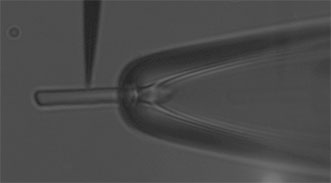To study the response of retinal cells to light, a team of researchers has developed a new technique involving tapered optical fibers that could also have applications in optogenetics.
Led by the International School for Advanced Studies (SISSA) in Trieste, Italy, the study scrutinized rods, the light-sensitive cells of the retina, and demonstrated that the intensity of their response varies according to the region of the cell hit by the light.
The technique combines electrosuction, or suction of a single cell into the tip of a glass electrode, with the use of titanium-gold-coated, apertureless, tapered optical fibers that allow delivery of highly confined spots of light.

A rod in physical contact with a tapered optical fiber. Courtesy of the International School for Advanced Studies.
Using these fibers, the researchers analyzed in detail the response of rhodopsin, the pigment protein underlying vision. For this reason, they believe the technique can be useful in the field of optogenetics, a technique that enables control of neurons that have been genetically sensitized to light.
In the present study, researchers found that stimulating the tip of the rod produces a weaker response than stimulating the base, with a gradient of efficacy along the segment. Specifically, as light stimulus traveled from the base to the tip, the amplitude of saturating and single-photon responses decreased 5 to 10 times.
Rods are small cylindrical structures connected to the cell body. They give rise to the axon, the projection from which electrical impulses travel toward other neurons to become visual perception. The rod's outer segment is made up of stacked disks, each containing many types of proteins, including rhodopsin.
"The gradient is probably due to the fact that the disks making up the rod undergo constant renewal: disks at the tip are older, and those at the base are newer," said Vincent Torre, a SISSA professor and study coordinator.
Previously it had been thought that the outer segments of rods were mostly homogenous in their composition and response to light, but the SISSA study demonstrates that is not the case. The researchers said their work has advanced understanding of the process of transduction of visual stimuli, that is, the transformation of light first into a biochemical process and finally into an electrical nerve potential.
The research was published in the Proceedings of the National Academy of Sciences (doi: 10.1073/pnas.1423162112 [open access]).
For more information, visit www.sissa.it.